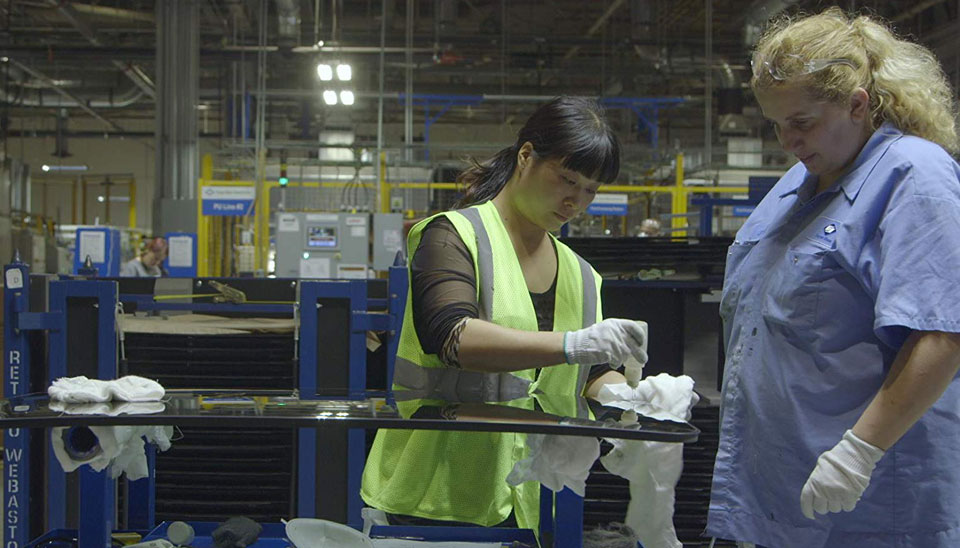
On August 21, Netflix, a global network reaching 190 countries, and a select group of big-screen North American theaters will release American Factory, a documentary examining the confluence of Chinese and American business and labor models focusing on a re-tooled GM plant in Dayton, Ohio, that is now Fuyao Glass America. I won’t wait to the end of this review to state that this is must viewing for anyone interested in the future of American labor and the nature of Chinese industry and its labor force. Understanding the forces at work as revealed in this film will help to confront the challenge of automation that is already fully upon us.
There is a new class of Chinese industrialists and billionaires who have been allowed to amass fantastic personal wealth if they do their share in continuing to lift the national economy. China’s output is now second only to the United States, and much greater in certain sectors. It is predicted to become #1 very shortly. This is by any measure the single largest social transformation in the history of humanity, and like it or not, it is the guidance of the Chinese Communist Party since 1949 that has created this miracle of long-term planning and hard work.
Has there been a price for this extraordinary economic and social phenomenon? Definitely. Has it been worth it? That’s purely a rhetorical question by now: People all over the world want to rise up out of crushing poverty and enjoy the good things of life. The only pragmatic question to ask is, How to do it?
With lyrical elegance of means, the 110-minute American Factory shows both the strengths and the weaknesses of American and Chinese models, without overt judgment. The imperious Chairman Cao of Fuyao Glass, which has dozens of factories in China and abroad, has bought up a post-industrial hulk of an auto factory in distressed Ohio, invested close to $500 million to remodel it for manufacturing glass for the auto industry, and providing jobs to a workforce that has been unemployed since GM shut down. Fuyao also secured millions of dollars in tax incentives from the state, city, and county to get the factory up and running. Now the pay is less than half of what some of these folks earned before, but they have some of their pride and dignity back.
Initial hopefulness and optimism start fraying at the edges, however, when they begin to understand the demands that will be made of them by their new high-tech bosses. Industrial accidents are more frequent now, environmental and OSHA protections go unheeded, building codes are ignored, and workers are let go for speaking out on the need for a union. “Safe doesn’t pay the bills,” a company spokesman says. The Chairman hires a union avoidance consulting firm to ensure that when the eventual vote takes place over reinstating the United Auto Workers as the bargaining unit, it will go the company’s way.
Directors Steven Bognar and Julia Reichert showed this non-fiction feature at the 2019 Sundance Film Festival, and Netflix acquired it. The film garnered the Directing Award for U.S. Documentary and immediately looked like a top contender for a 2020 Oscar.
In their post-presidential lives, Barack and Michelle Obama have launched Higher Ground Productions, partnering with Netflix, “to harness the power of storytelling,” in the former president’s words. This title is the first Higher Ground release to premiere on Netflix.
Fuyao employs over a thousand workers in Dayton, about one from China for every four or five Americans. The filmmakers had almost unlimited access from the beginning of the factory rebuilding to the time after the UAW vote takes place, a period of three years. We get to meet a number of members on the Chinese team as well as the Americans who are struggling to understand the new labor ethos the Chinese are promoting.
Some of the footage the film crew captured, of the Chinese managers lecturing their Chinese employees, for example, is damningly revealing of attitudes of Chinese superiority, as well as flouting American labor law. The Chinese resent their inability to force workers to work overtime, as they can easily do at home. The Americans respond, “You can’t spell Fuyao without FU.”
We get to travel to China for a Fuyao company New Year banquet and show, where we see the amazing personal sacrifice, discipline, and regimentation that characterize Chinese culture and which are so alien to the American sensibility. The Ohio workers invited to the festivities are all hefty dudes, contrasting visibly, at least in part, with the Chinese industrial slogan of the day, “intelligence and lean.” The implication is clear that it is only by harnessing China’s vast labor energy toward a single-minded purpose, and by the introduction where possible of robotics to save time and labor and eliminate human error, that the most populous nation on Earth has leapt to the forefront of the world stage.
Chairman Cao’s brother-in-law is both head of the Fuyao workers’ union and of the Communist Party. The company has ample government backing. There is no “anarchy of private production” here. The banquet would not be complete without the simultaneous on-stage wedding of six young Fuyao couples, and a propaganda number performed by adorable little Fuyao children dressed in yellow as hardworking chickens.
If that strategy was necessary for China, can it, and should it be applied to America’s workforce? Has the direction of investment now reversed itself, with more significant Chinese share in the American economy than American in the Chinese? Time will tell, but the film seems to point to what popular wisdom understands: That the U.S. is a spent power now, flailing wildly to retain its position (mostly by military might), while China is poised to assume world leadership with its steady, long-range “soft-power” vision of success and harmony under its tutelage.
American Factory is a visually stunning film, with balletic camera work starting with streams of oaken-hued sand that will be transformed into flawless transparent windshields. If we see workers on the job, we often hear not the intensely loud noise of the factory but their quiet off-camera interview voices intimating their interior thoughts. The documentary also features a truly wondrous score by Chad Cannon.
This is in no way a company promotional puff-piece. It’s fair-minded, with nuanced positive and negative aspects brought out on both the Chinese and the American sides. It would be folly not to pay attention to the modalities of work the Chinese are now trying to impose on industrial manufacturing around the world, including in America.
U.S.-owned companies have their own forms of dehumanizing standardization and regimentation, of course, with or without unions—ask the folks at Walmart and Amazon. Competitive practice in the future may involve a melding of industrial styles that will likely not satisfy most workers.
Unless they somehow get it together to re-imagine an economy and a labor force, separated from and opposed to capitalist modes of production, that could be built under socialism.
But wait a minute…Isn’t China supposed to be building socialism? There is much to ponder in this film.
The trailer can be viewed here.










